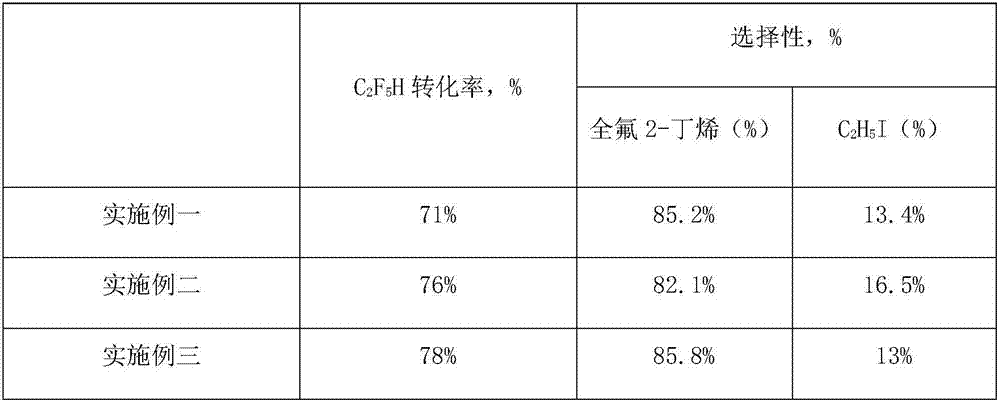Method for synthesizing perfluorobut-2-ene by gas phase catalysis
A technology of butene and catalyst, which is applied in the field of organic synthesis, can solve the problems of easy decomposition, high price, and ignition temperature of only 180°C, and achieve the effects of convenient transportation and storage, reduced production cost, and increased possibility
- Summary
- Abstract
- Description
- Claims
- Application Information
AI Technical Summary
Problems solved by technology
Method used
Image
Examples
Embodiment 1
[0032] ① Catalyst preparation
[0033] Weigh 50 g of pretreated columnar coconut shell activated carbon, and then soak it in KF solution containing 10% of its mass fraction. After ultrasonicating the impregnating solution for 30 minutes, naturally impregnate for 8 hours, and then use a rotary evaporator to distill the impregnating solution under reduced pressure. After the impregnating solution is distilled, the catalyst is prepared.
[0034] ②Catalyst activation and pretreatment before reaction
[0035] Feed 150ml / min of N into the reactor equipped with 30ml catalyst 2 , and then the reactor was heated to 150° C. at a heating rate of 300° C. / h and kept for 4 hours to dry the catalyst. After drying for 4 hours, continue to heat the reactor to 500° C. at a heating rate of 300° C. / h and keep it for 4 hours to activate the catalyst. After the activation is completed, continue to heat the reactor to 550°C at a heating rate of 300°C / h and maintain a constant temperature. Adjust...
Embodiment 2
[0039] ① Catalyst preparation
[0040] Take the pretreated columnar coconut shell activated carbon 50g, then impregnate it in KNO containing 10% of its mass fraction 3in solution. After ultrasonicating the impregnating solution for 30 minutes, naturally impregnate for 8 hours, and then use a rotary evaporator to distill the impregnating solution under reduced pressure. After the impregnating solution is distilled, the catalyst is prepared.
[0041] ②Catalyst activation and pretreatment before reaction
[0042] Feed 150ml / min of N into the reactor equipped with 30ml catalyst 2 , and then the reactor was heated to 150° C. at a heating rate of 300° C. / h and kept for 4 hours to dry the catalyst. After drying for 4 hours, continue to heat the reactor to 500° C. at a heating rate of 300° C. / h and keep it for 4 hours to activate the catalyst. After the activation is completed, continue to heat the reactor to 550°C at a heating rate of 300°C / h and maintain a constant temperature. ...
Embodiment 3
[0046] ① Catalyst preparation
[0047] Weigh 50 g of pretreated columnar coconut shell activated carbon, and then impregnate it in Ce(NO 3 ) 3 ﹒ 6H 2 O and Ca(NO 3 ) 2 Mixed solution (mass ratio 1:1). After ultrasonicating the impregnating solution for 30 minutes, naturally impregnate for 8 hours, and then use a rotary evaporator to distill the impregnating solution under reduced pressure. After the impregnating solution is distilled, the catalyst is prepared.
[0048] ②Catalyst activation and pretreatment before reaction
[0049] Feed 150ml / min of N into the reactor equipped with 30ml catalyst 2 , and then the reactor was heated to 150° C. at a heating rate of 300° C. / h and kept for 4 hours to dry the catalyst. After drying for 4 hours, continue to heat the reactor to 500° C. at a heating rate of 300° C. / h and keep it for 4 hours to activate the catalyst. After the activation is completed, continue to heat the reactor to 600°C at a heating rate of 300°C / h and keep th...
PUM
| Property | Measurement | Unit |
|---|---|---|
| boiling point | aaaaa | aaaaa |
Abstract
Description
Claims
Application Information
 Login to View More
Login to View More - R&D
- Intellectual Property
- Life Sciences
- Materials
- Tech Scout
- Unparalleled Data Quality
- Higher Quality Content
- 60% Fewer Hallucinations
Browse by: Latest US Patents, China's latest patents, Technical Efficacy Thesaurus, Application Domain, Technology Topic, Popular Technical Reports.
© 2025 PatSnap. All rights reserved.Legal|Privacy policy|Modern Slavery Act Transparency Statement|Sitemap|About US| Contact US: help@patsnap.com



